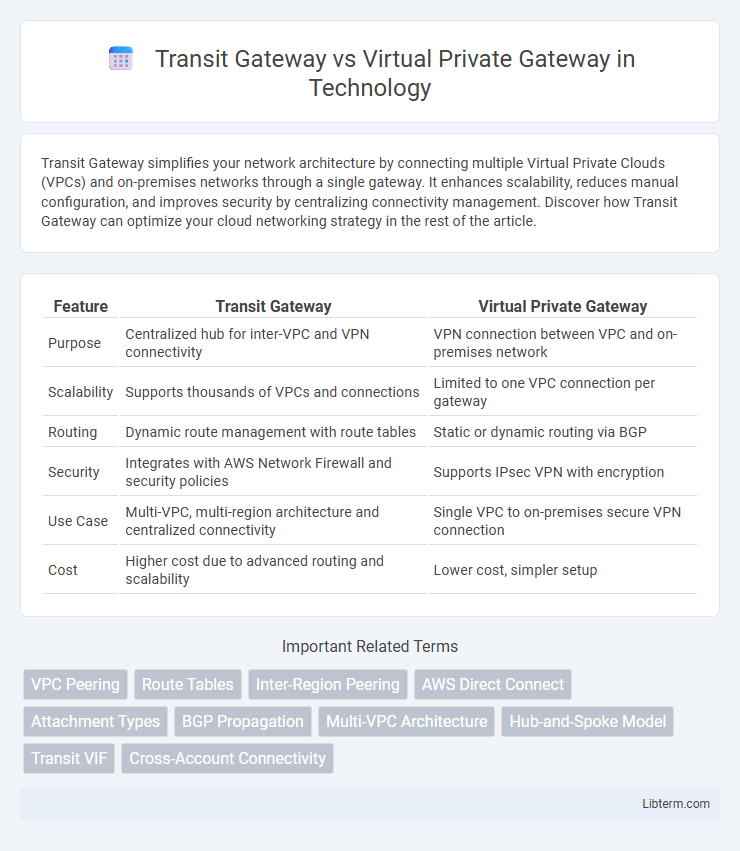Transit Gateway simplifies your network architecture by connecting multiple Virtual Private Clouds (VPCs) and on-premises networks through a single gateway. It enhances scalability, reduces manual configuration, and improves security by centralizing connectivity management. Discover how Transit Gateway can optimize your cloud networking strategy in the rest of the article.
Table of Comparison
| Feature | Transit Gateway | Virtual Private Gateway |
|---|---|---|
| Purpose | Centralized hub for inter-VPC and VPN connectivity | VPN connection between VPC and on-premises network |
| Scalability | Supports thousands of VPCs and connections | Limited to one VPC connection per gateway |
| Routing | Dynamic route management with route tables | Static or dynamic routing via BGP |
| Security | Integrates with AWS Network Firewall and security policies | Supports IPsec VPN with encryption |
| Use Case | Multi-VPC, multi-region architecture and centralized connectivity | Single VPC to on-premises secure VPN connection |
| Cost | Higher cost due to advanced routing and scalability | Lower cost, simpler setup |
Introduction to AWS Transit Gateway and Virtual Private Gateway
AWS Transit Gateway enables centralized connectivity for multiple Amazon VPCs and on-premises networks, simplifying network management and improving scalability. Virtual Private Gateway acts as a VPN concentrator on the AWS side of a VPC, allowing secure site-to-site VPN connections between an on-premises network and a single VPC. Transit Gateway supports complex network architectures with high throughput, while Virtual Private Gateway typically serves specific VPN or Direct Connect links to individual VPCs.
Core Functionality: Transit Gateway vs Virtual Private Gateway
Transit Gateway serves as a centralized hub that interconnects multiple Amazon VPCs, on-premises networks, and remote offices, simplifying network architecture and managing traffic efficiently. Virtual Private Gateway primarily provides a secure VPN connection between a specific VPC and an on-premises network, enabling encrypted communication over the internet. Transit Gateway supports scalable and complex topologies with high throughput, whereas Virtual Private Gateway is designed for point-to-site or site-to-site VPN use cases with limited scaling capabilities.
Architecture and Network Topology
Transit Gateway architecture centralizes network connectivity by acting as a hub that interlinks multiple VPCs, VPNs, and on-premises networks, supporting scalable and simplified routing through a single gateway. Virtual Private Gateway architecture provides a dedicated VPN connection point specifically for a single VPC, directly linking it to an external network such as an on-premises data center. Network topology for Transit Gateway adopts a hub-and-spoke model enabling efficient multi-VPC communication, while Virtual Private Gateway maintains a point-to-site topology focusing on secure site-to-site connections.
Scalability and Performance Comparison
Transit Gateway offers high scalability by enabling seamless interconnection of thousands of VPCs and on-premises networks through a single gateway, significantly enhancing network performance with optimized routing and reduced latency. Virtual Private Gateway, designed primarily for VPN connections to single VPCs, limits scalability and may introduce bottlenecks in complex architectures due to its point-to-point nature. Transit Gateway supports higher bandwidth and more flexible traffic management, making it ideal for large-scale, multi-VPC environments requiring robust performance and scalability.
Security Features and Best Practices
Transit Gateway offers centralized security management with integrated firewall policies and route controls, enabling scalable protection across multiple VPCs and on-premises networks. Virtual Private Gateway provides secure, encrypted VPN tunnels for site-to-cloud connectivity but is limited in multi-VPC traffic routing and comprehensive security controls. Best practices recommend using Transit Gateway for complex architectures demanding granular access control and threat isolation while ensuring proper encryption, monitoring, and regular security audits in both gateway types.
Cost Considerations and Pricing Structure
Transit Gateway pricing is based on hourly attachment fees and data processing charges per gigabyte, making it cost-effective for complex, large-scale AWS network architectures that require multiple VPC and on-premises connections. Virtual Private Gateway incurs costs primarily from VPN connection hourly rates and data transfer out, suitable for simpler, point-to-point VPN setups. Evaluating workload size and connectivity needs is crucial to optimize spending between the Transit Gateway's scalable pricing model and the more straightforward, lower-overhead Virtual Private Gateway fees.
Integration with AWS Services
Transit Gateway offers seamless integration with multiple AWS services such as Amazon VPC, AWS Direct Connect, and AWS VPN, enabling centralized and scalable network management across hundreds of VPCs. Virtual Private Gateway primarily supports AWS Site-to-Site VPN connections for secure communication between on-premises networks and a single VPC, with limited integration capabilities compared to Transit Gateway. AWS Transit Gateway enhances connectivity and simplifies routing policies for large-scale AWS environments, while Virtual Private Gateway remains suitable for straightforward VPN-based use cases.
Use Cases and Deployment Scenarios
Transit Gateway enables centralized, scalable interconnectivity across multiple Amazon VPCs, on-premises networks, and remote offices, making it ideal for enterprise networks requiring simplified management and high-performance routing. Virtual Private Gateway is best suited for single VPC connectivity to an on-premises network via VPN or AWS Direct Connect, commonly deployed for hybrid cloud architectures needing secure access. Organizations use Transit Gateway in complex multi-region and multi-account scenarios, while Virtual Private Gateway fits well in straightforward, point-to-site or site-to-site VPN use cases.
Management and Monitoring Tools
Transit Gateway supports centralized management and monitoring through AWS Transit Gateway Network Manager, providing real-time visibility and operational insights across large-scale cloud networks. Virtual Private Gateway relies primarily on Amazon CloudWatch for monitoring VPN connections and VPC traffic, offering basic metrics and alarms specific to individual gateways. Transit Gateway's integrated dashboards and automated event detection simplify multi-site network management unlike the more limited, gateway-specific monitoring tools of Virtual Private Gateway.
Choosing the Right Gateway Solution
Transit Gateway offers scalable connectivity by enabling centralized management of multiple VPCs and on-premises networks, making it ideal for complex architectures requiring high throughput and simplified routing. Virtual Private Gateway is best suited for establishing secure VPN connections between a single VPC and on-premises networks, providing a cost-effective solution for simpler, point-to-point setups. Selecting the right gateway depends on network complexity, scalability needs, and the number of VPCs involved in the architecture.
Transit Gateway Infographic

 libterm.com
libterm.com